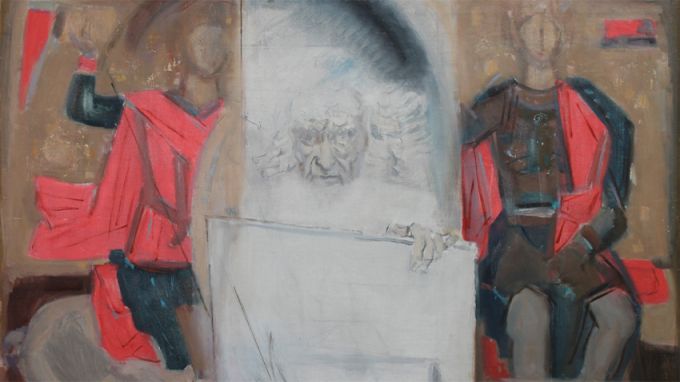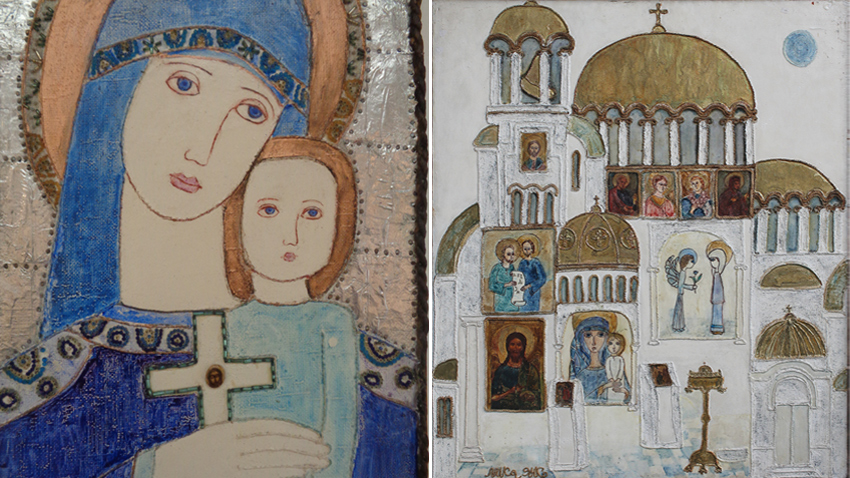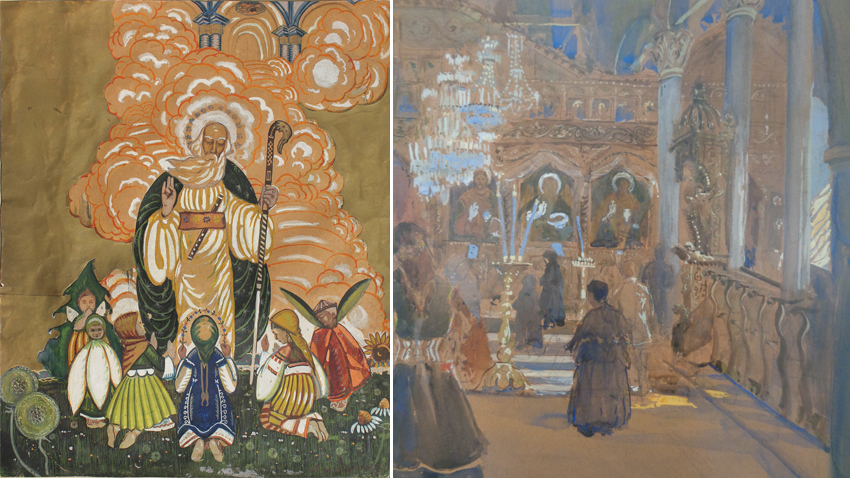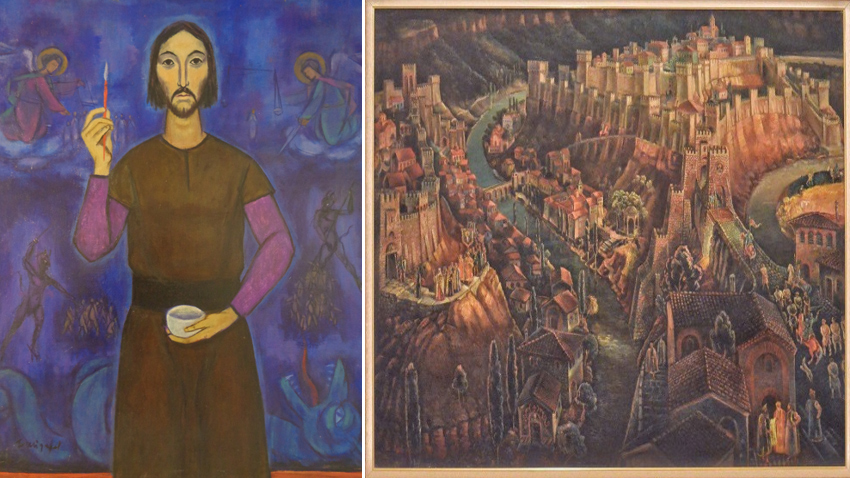 6
6
An exhibition named “The icon-a symbol and image in modern Bulgarian art” is on display at the Sofia City Art Gallery. It will last until February 4. The exposition is dedicated to the icon and its impact on the secular art. Over 100 works grouped into several thematic sections have been displayed at this exhibition.
“I have been interested in the topic related to the presence of the icon in the contemporary art or rather in modern art and secular works for nearly one and a half years, curator of the exhibition Lyuben Domozetski told Radio Bulgaria. I have been searching for authors who started to present icons in one way or another after Bulgaria’s liberation from the Ottoman rule. Some of the icons are part of the interior of the buildings, some are part of a landscape and some are part of a given ritual. Some authors present the icon as a starting point for new images which was typical of the 1920’s for instance when they were extremely popular in the Bulgarian secular art.”
 The icons of this exhibition were created between 1878 (the liberation from Ottoman rule) until 1989 (the start of transition to democracy). How much the authors of these icons, who worked after the liberation of Bulgaria, were influenced by the medieval and renaissance artists?
The icons of this exhibition were created between 1878 (the liberation from Ottoman rule) until 1989 (the start of transition to democracy). How much the authors of these icons, who worked after the liberation of Bulgaria, were influenced by the medieval and renaissance artists?
“The interest towards medieval art increased in certain periods. If we look at some of the earliest foreign-born authors who came to Bulgaria we will find out that they were quite impressed by the antiquities they found. Everything was important for them-from the smallest detail on the colorful folk costumes of the local population to the smallest detail in the design of a Balkan Christian temple, including the icons placed on the church walls and the icons from the altar rails.”
 Lyuben Domozetski gave an example with one of the brightest artists in post-liberation Bulgaria- the Czech artist Ivan Mrkvicka who presented on one of his paintings a church service with lamb. Mrkvicka paid attention to the smallest detail-from the elements on the national folk costume and the two burning candles placed over the lamb’s head to the interior design. An icon can be seen behind the priest. In fact, this icon is present in the church space and is part of an entity depicting the church interior and the religious life of the Balkans nations.
Lyuben Domozetski gave an example with one of the brightest artists in post-liberation Bulgaria- the Czech artist Ivan Mrkvicka who presented on one of his paintings a church service with lamb. Mrkvicka paid attention to the smallest detail-from the elements on the national folk costume and the two burning candles placed over the lamb’s head to the interior design. An icon can be seen behind the priest. In fact, this icon is present in the church space and is part of an entity depicting the church interior and the religious life of the Balkans nations.
Works of Austrian artist Joseph Oberbauer and Czech artist Joseph Peter who painted life in ancient Sofia are also present at the exhibition.
 “We can imagine how Sofia looked like at the end of the 19th century soon after Bulgaria’s liberation from the Ottoman rule. There were only few modern buildings, the streets were full of mud and no asphalt was laid on them. These are mainly one-storey poky buildings. However, some ancient buildings from different periods have been preserved such as the Saint Sofia church, Saint George Rotunda, etc. The foreign authors were also impressed by this different Balkan reality.”
“We can imagine how Sofia looked like at the end of the 19th century soon after Bulgaria’s liberation from the Ottoman rule. There were only few modern buildings, the streets were full of mud and no asphalt was laid on them. These are mainly one-storey poky buildings. However, some ancient buildings from different periods have been preserved such as the Saint Sofia church, Saint George Rotunda, etc. The foreign authors were also impressed by this different Balkan reality.”
Icons are also shown in another context-during the presentation of paintings of historic nature which are connected with the medieval and national revival period and the topic related to the icon-painters. Artists are quite excited with these topics, Lyuben Domozetski points out. The icon for instance is present in composition linked with the Second Bulgarian Kingdom and its capital Tarnovgrad. It either watches over the head of the expectant mother, or the national revival hero is compared to a warrior on a horse who defeats the evil embodied in a dragon.
 After Bulgaria’s liberation from the Ottoman rule the Bulgarian religious art followed the academic line, art critic Domozetski adds. It is interesting to note that in the 1920s the secular art turns to the aesthetics of the medieval icon - the number of contemporary authors interested in Byzantine art and icon-painting, frescoes and manuscripts increased. This was influenced by the quest for modernization of Bulgarian art through the search of a national appearance. According to curator Domozetski, this is clearly seen in the works of the celebrated Bulgarian artists Ivan Milev and Ivan Penkov who worked in the 1920’s. Speaking of the influence of iconography over secular art, we should not forget the influence of the art language– the inclusion of halos, gold, linear and flatter decorative representation of the form. Of course all this has a deeper meaning and this emblematic language is not accidental and due to the icon-painter’s whim. These specifics typical of medieval art sometimes impress the authors, Lyuben Domozetski points out.
After Bulgaria’s liberation from the Ottoman rule the Bulgarian religious art followed the academic line, art critic Domozetski adds. It is interesting to note that in the 1920s the secular art turns to the aesthetics of the medieval icon - the number of contemporary authors interested in Byzantine art and icon-painting, frescoes and manuscripts increased. This was influenced by the quest for modernization of Bulgarian art through the search of a national appearance. According to curator Domozetski, this is clearly seen in the works of the celebrated Bulgarian artists Ivan Milev and Ivan Penkov who worked in the 1920’s. Speaking of the influence of iconography over secular art, we should not forget the influence of the art language– the inclusion of halos, gold, linear and flatter decorative representation of the form. Of course all this has a deeper meaning and this emblematic language is not accidental and due to the icon-painter’s whim. These specifics typical of medieval art sometimes impress the authors, Lyuben Domozetski points out.
The national painting triennial with the theme "Bridges" will bring together 84 contemporary artists who will show 106 works in the Hristo Tsokev Art Gallery in Gabrovo. This year's theme of the exhibition - "Bridges" - includes two aspects,..
The OKO International Ethnographic Film Festival will be held in Sofia in the period November 8 to November 15th. The forum is realized with the support of the National Film Center, Sofia Municipality, the Embassy of Ukraine and the..
For the first time in Sofia, the British show STOMP will perform in Hall 1 of the National Palace of Culture (NDK) from 8 to 10 November 2024. The show, which combines dance, music and theatre, will present its infectious blend of rhythm, drama and..

+359 2 9336 661
